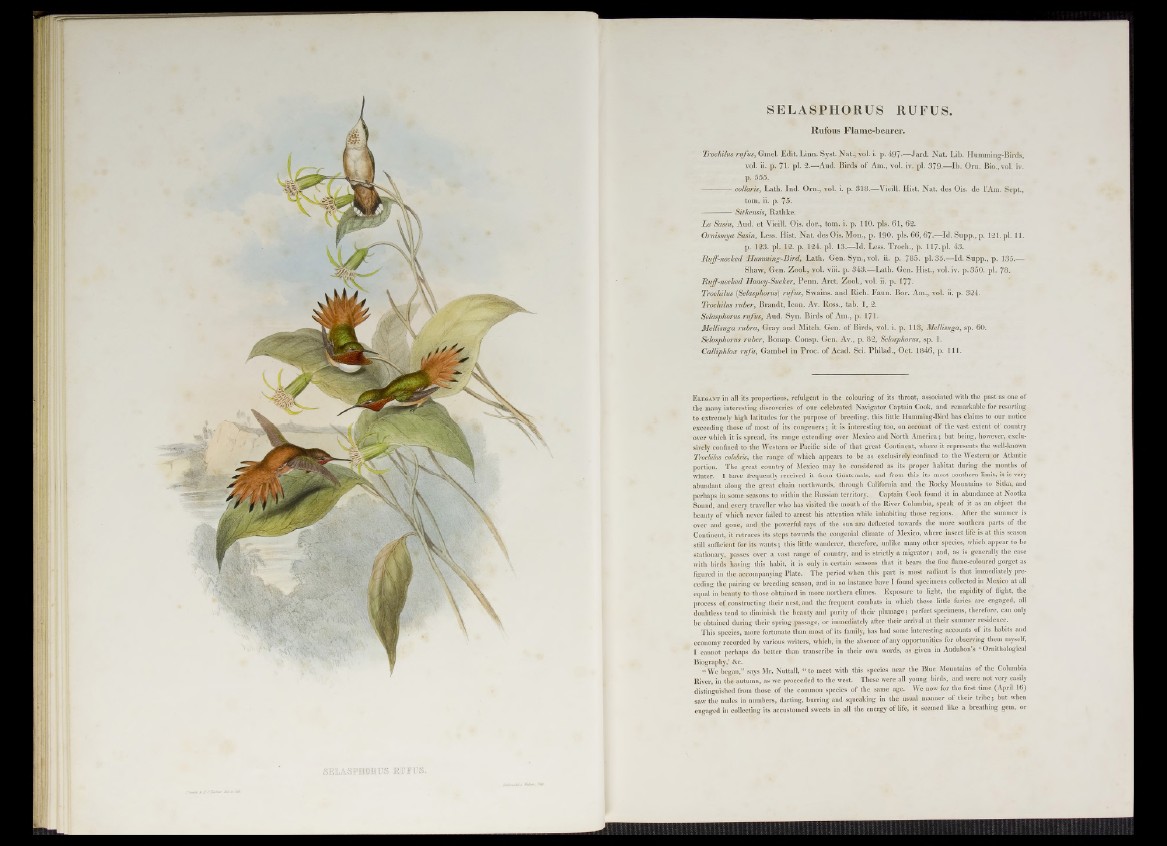
SEILASPBDMIS RHJFHJS.
SELASPHORUS RUFUS.
Rufous Fiarae-bearer.
Trochilus n tfu s, Gmel. Edit. Linn. Syst. Nat., vol. i. p. 497-—Jard. Nat. Lib. Humming-Birds,
vol. ii. p. 71- pi. 2-—Aud. Birds o f Am., vol. iv. pi. 379-—lb . Orn. Bio., vol. iv.
p^ 555.
-------------collaris, Lath. Ind. Orn., vol. i. p. 318.— Vieill. Hist. Nat. des Ois. de l’Am. Sept.,
tom. ii. p. 75.
-------------Sitkensis, Rathke.
L e Sasin, Aud. et Vieill. Ois. dor., tom. i. p. 110. pis. 61, 62.
Ornismya Sasin, Less. Hist. Nat. des Ois. Mon., p. 190. pis. 6 6 ,67#^Id. Supp., p. 121.pl. 11.
p. 123. pi. 12. p. 124. pi. 13.—Id. Less. Troch., p. 117- pi. 43.
Huff-necked Humming-Bird, Lath. Gen. Syn., vol. ii. p. 785. pi. 35.—Id. Supp., p. 135.—
Shaw, Gen. Zool., vol. viii. p. 343.—Lath. Gen. Hist., vol. iv. p. 350. pi. 78.
Huff-necked Honey-Sucker, Penn. Arct. Zool., vol. ii. p. 177-
Trochilus [Selasphorus) rufus, Swains, and Rich. Faun. Bor. Am., vol. ii. p. 324.
Trochilus ruber, Brandt, Icon. Av. Ross., tab. 1, 2.
Selasphorus n tfu s, Aud. Syn. Birds of Am., p. 171.
Mellisuga rubra, Gray and Mitch. Gen. of Birds, vol. i. p. 113, Mellisuga, sp. 60.
Selosphorus ruber, Bonap. Consp. Gen. Av., p. 82, Selosphorus, sp. 1.
Calliphlox rufa, Gambel in Proc. of Acad. Sci. Philad., Oct. 1846, p. 111.
E l e g a n t in all its proportions, refulgent in the colouring of its throat, associated with the past as one of
the many interesting discoveries of our celebrated Navigator Captain Cook, and remarkable for resorting
to extremely high latitudes for the purpose of breeding, this little Humming-Bird has claims to our notice
exceeding those of most of its congeners; it is interesting too, on account of the vast extent of country
over which it is spread, its range extending over Mexico and North America; but being, however, exclusively
confined to the Western or Pacific side of that great Continent, where it represents the well-known
Trochilus colubris, the range of which appears to be as exclusively confined to the Western or Atlantic
portion. The great country of Mexico may be considered as its proper habitat during the months of
winter. I have frequently received it from Guatemala, and from this its most southern limit, it is very
abundant along the great chain northwards, through California and the Rocky Mountains to Sitka, and
perhaps in some seasons to within the Russian territory. Captain Cook found it in abundance at Nootka
Sound, and every traveller who has visited the mouth of the River Columbia, speak of it as an object the
beauty of which never failed to arrest his attention while inhabiting those regions. After the summer is
over and gone, and the powerful rays of the sun are deflected towards the more southern parts of the
Continent, it retraces its steps towards the congenial climate of Mexico, where insect life is at this season
still sufficient for its wants; this little wanderer, therefore, unlike many other species, which appear to be
stationary, passes over a vast range of country, and is strictly a migrator; and, as is generally the case
with birds having this habit, it is only in certain seasons that it bears the fine flame-coloured gorget as
figured in the accompanying Plate. The period when this part is most radiant is that immediately preceding
the pairing or breeding season, and in no instance have I found specimens collected in Mexico at all
equal in beauty to those obtained in more northern climes. Exposure to light, the rapidity of flight, the
process of constructing their nest, and the frequent combats in which these little furies are engaged, all
doubtless tend to diminish the beauty and purity of their plumage; perfect specimens, therefore, can only
be obtained during their spring passage, or immediately after their arrival at their summer residence.
This species, more fortunate than most of its family, has had some interesting accounts of its habits and
economy recorded by various writers, which, in the absence of any opportunities for observing them myself,
I cannot perhaps do better than transcribe in their own words, as given in Audubon’s ‘ Ornithological
Biography,’ &c.
“ We began,” says Mr. Nuttall, “ to meet with this species near the Blue Mountains of the Columbia
River, in the autumn, as we proceeded to the west. These were all young birds, and were not very easily
distinguished from those of the common species of the same age. We now for the first time (April 16)
saw the males in numbers, darting, burring and squeaking in the usual manner of their tribe; but when
engaged in collecting its accustomed sweets in all the energy of life, it seemed like a breathing gem, or